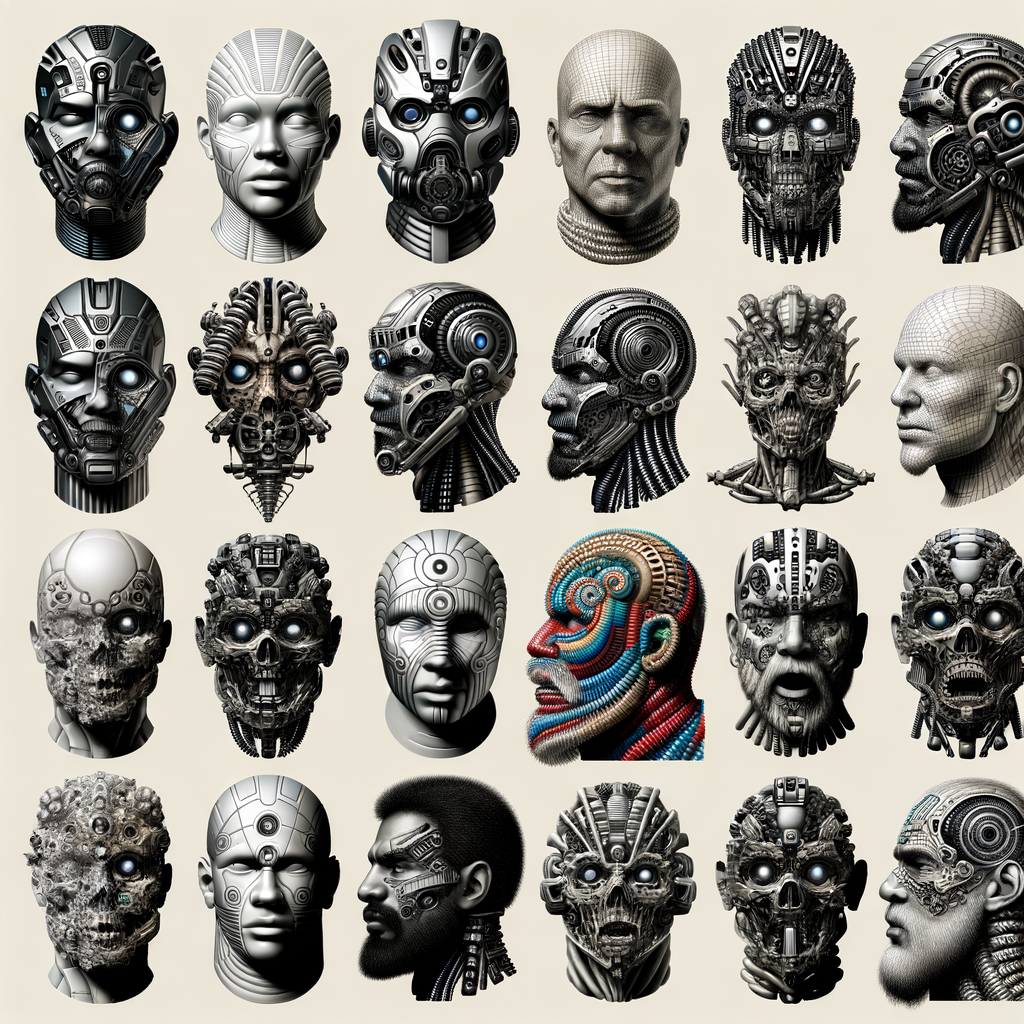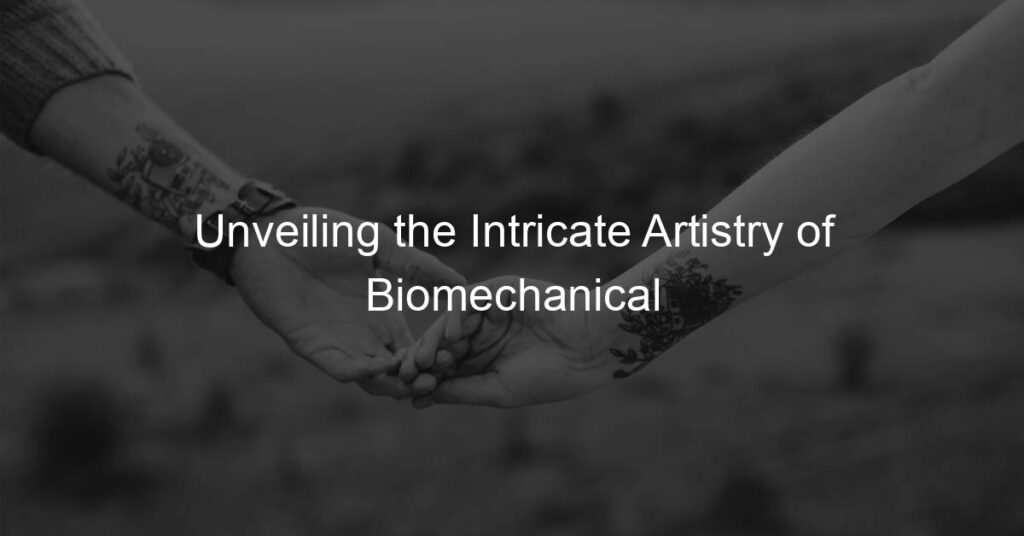
Introduction to Biomechanical Tattoo Designs
Welcome to the fascinating world of biomechanical tattoos. These unique designs blend the human body with mechanical elements, creating a futuristic and captivating art form. In this section, we’ll explore the definition, history, and symbolism of these tattoos.
-
- Definition of Biomechanical Tattoos
Biomechanical tattoos are a genre of body art that merges elements of machinery or robotics with the human anatomy. The designs often give the illusion that the wearer’s body is part machine, with gears, wires, and other mechanical components visible beneath the skin. This style of tattooing is heavily influenced by science fiction and cyberpunk aesthetics.
-
- History and Evolution of Biomechanical Tattoos
The concept of biomechanical tattoos originated in the late 1970s and early 1980s, inspired by the surreal artwork of H.R. Giger, a Swiss artist known for his work on the science fiction film, “Alien”. Over the years, the style has evolved, with artists adding their unique twists and incorporating modern technology themes. Today, biomechanical tattoos are a popular choice for those who want to express their love for science fiction, technology, or simply to stand out from the crowd.
-
- Significance and Symbolism of Biomechanical Tattoos
Biomechanical tattoos often symbolize the connection between humans and technology. They can represent the idea that technology is an integral part of our lives, almost as if it’s a part of our bodies. Some people choose these designs to express their fascination with the future, while others see them as a commentary on our reliance on machines. Regardless of the specific meaning, these tattoos are a powerful way to make a statement.
Exploring Different Tattoo Art Styles
In the vast world of tattoo art, there are countless styles and designs to choose from. Each style has its unique characteristics and appeal. One of the most enduring and popular styles is the traditional tattoo style.
Traditional Tattoos
Traditional tattoos, also known as old school tattoos, have been around for decades. They are known for their bold lines, vibrant colors, and iconic designs. Let’s delve deeper into the characteristics and popular designs of traditional tattoos.
-
- Characteristics of Traditional Tattoos
Traditional tattoos are characterized by their simplicity and boldness. They typically feature solid black outlines filled in with bright, flat colors. The designs are often simple, yet striking, with a limited color palette. Shading is minimal in traditional tattoos, and the focus is more on the bold lines and clear, easily recognizable images. These tattoos are often symmetrical and are designed to be as clear and readable as possible.
-
- Popular Traditional Tattoo Designs
There are several iconic designs associated with traditional tattoos. Some of the most popular ones include:
-
-
- Nautical themes: Sailors were among the first to popularize traditional tattoos, so nautical themes like anchors, ships, and swallows are common.
- Roses: The rose is a classic traditional tattoo design, symbolizing love and beauty.
- Hearts: Hearts, often accompanied by banners and text, are another staple of traditional tattoo designs.
- Eagles: Eagles represent freedom and strength, making them a popular choice for traditional tattoos.
-
These are just a few examples. The beauty of traditional tattoos lies in their versatility and timeless appeal.
Whether you’re a tattoo enthusiast or a novice, understanding different tattoo art styles can help you appreciate the artistry and craftsmanship behind each design. Stay tuned as we continue to explore more tattoo styles in our upcoming posts.
Biomechanical Tattoos
Biomechanical tattoos are a unique and captivating form of body art. They combine elements of machinery and biology to create a futuristic and surreal aesthetic. Let’s delve into the characteristics of these tattoos and explore some popular designs.
-
- Characteristics of Biomechanical Tattoos
Biomechanical tattoos are known for their intricate detail and realistic representation of mechanical and biological elements. They often depict machinery parts like gears, pistons, and wires, intertwined with human muscles, bones, or veins. The result is a stunning illusion that the wearer’s body is part machine.
These tattoos often utilize a 3D effect, giving them depth and making them appear as if they are truly part of the wearer’s body. They are typically done in grayscale, but some artists use splashes of color for a more dramatic effect.
Biomechanical tattoos require a high level of skill and precision from the tattoo artist. They are time-consuming and can be more expensive than other tattoo styles due to their complexity.
-
- Popular Biomechanical Tattoo Designs
There are countless designs available for biomechanical tattoos, each one unique and fascinating. Here are a few popular choices:
-
-
- Robot Arm: This design gives the illusion that the wearer’s arm is made of mechanical parts.
- Alien Machinery: These designs incorporate alien-like organic forms mixed with mechanical elements.
- Heart Gears: A design that depicts the heart as a complex machine with gears and cogs.
- Spine Mechanics: This design gives the illusion of a mechanical spine under the wearer’s skin.
-
These are just a few examples. The possibilities for biomechanical tattoo designs are limited only by the wearer’s and artist’s imaginations.
Biomechanical tattoos are a testament to the creativity and skill of tattoo artists. They offer a unique way for individuals to express their fascination with the fusion of biology and machinery. Whether you’re a fan of science fiction, a lover of surreal art, or simply someone who appreciates intricate and detailed designs, biomechanical tattoos offer a unique and captivating form of self-expression.
Unraveling the Futuristic Appeal of Biomechanical Tattoos
Biomechanical tattoos have a unique appeal that transcends the traditional boundaries of tattoo art. They combine elements of science fiction, intricate mechanical structures, and cutting-edge 3D design techniques to create a futuristic aesthetic that is both captivating and thought-provoking. Let’s delve into the key aspects that contribute to the futuristic appeal of biomechanical tattoos.
-
- Integration of Science Fiction and Art
Biomechanical tattoos are a perfect blend of science fiction and art. They often depict scenes and concepts from popular sci-fi movies and books, such as cyborgs, aliens, and futuristic machinery. This integration of science fiction and art results in designs that are not only visually stunning but also rich in narrative and symbolic meaning. For example, a biomechanical tattoo might depict a robotic arm, symbolizing the fusion of humans and technology and the potential future of our species.
-
- Depiction of Inner Mechanisms and Structures
Another key aspect of the futuristic appeal of biomechanical tattoos is the detailed depiction of inner mechanisms and structures. These tattoos often reveal the inner workings of mechanical devices, as if the skin has been peeled back to expose gears, pistons, and circuits beneath. This gives the illusion that the wearer’s body is part machine, further enhancing the futuristic and sci-fi feel of the design.
-
- 3D Biomechanical Tattoos: A New Dimension in Tattoo Art
The advent of 3D tattooing techniques has added a new dimension to the art of biomechanical tattoos. These techniques allow artists to create designs that appear to be three-dimensional, giving the illusion of depth and realism. 3D biomechanical tattoos often look as if they are part of the wearer’s body, as if their skin is made of metal and wires. This level of realism adds a whole new layer of appeal to biomechanical tattoos, making them even more captivating and futuristic.
In conclusion, the futuristic appeal of biomechanical tattoos lies in their unique blend of science fiction and art, their detailed depiction of inner mechanisms and structures, and the use of 3D tattooing techniques to create designs that appear to be part of the wearer’s body. These elements combine to create a style of tattoo art that is truly ahead of its time.
Spotlight on Renowned Biomechanical Tattoo Artists
Biomechanical tattoo art is a unique form of body art that blends elements of machinery and biology. This style has been popularized by several talented artists who have made a significant impact in the tattoo industry. Let’s take a closer look at three of these renowned artists and their notable works.
-
Artist 1: Paul Booth
Paul Booth is a legendary tattoo artist known for his dark and intricate biomechanical designs. Born in 1968, Booth started his tattooing career in the late 1980s. His unique style, which often incorporates skulls and other macabre elements, has earned him a dedicated following. One of his most notable works is the full-arm biomechanical sleeve he did for a famous rock musician.
-
Artist 2: Guy Aitchison
Another pioneer in the field of biomechanical tattoos is Guy Aitchison. Born in 1968, Aitchison has been tattooing since 1988. His work is known for its vibrant colors and intricate details, often resembling alien landscapes or inner body parts. Aitchison’s most famous work is perhaps a full back piece that depicts a colorful and complex biomechanical scene.
-
Artist 3: Aaron Cain
Aaron Cain is a tattoo artist who has been pushing the boundaries of biomechanical design since the 1990s. His work often features mechanical and organic elements intertwined in a surrealistic manner. One of Cain’s most notable works is a leg sleeve featuring a detailed biomechanical design that looks like a machine fused with human flesh.
These artists have not only mastered the art of biomechanical tattooing but have also contributed significantly to its popularity and evolution. Their unique styles and innovative designs continue to inspire both tattoo artists and enthusiasts around the world.
Understanding Tattoo Trends: The Rise of Biomechanical Tattoos
Biomechanical tattoos have been on the rise, captivating the attention of tattoo enthusiasts worldwide. These tattoos, which combine elements of machinery and biology, are a unique blend of art and science. But what has led to their increased popularity? Let’s delve into the factors that have influenced the rise of biomechanical tattoos.
Factors Influencing the Popularity of Biomechanical Tattoos
Like any trend, the popularity of biomechanical tattoos is driven by a combination of factors. These include cultural influence, technological advancements in tattooing, and a shift in tattoo preferences and styles.
-
- Cultural Influence
The popularity of science fiction and cyberpunk genres in movies, books, and video games has played a significant role in the rise of biomechanical tattoos. These genres often depict characters with mechanical body parts, inspiring fans to express their love for this aesthetic through tattoos.
-
- Technological Advancements in Tattooing
With the advent of new tattooing techniques and equipment, artists can now create intricate designs with a level of detail and precision that was not possible before. This has allowed for the creation of realistic biomechanical tattoos that truly resemble mechanical parts embedded in the skin.
-
- Shift in Tattoo Preferences and Styles
As people become more open to expressing their individuality through body art, there has been a shift towards more unique and personalized tattoo styles. Biomechanical tattoos, with their ability to be customized to the wearer’s preferences, fit perfectly into this trend.
In conclusion, the rise of biomechanical tattoos can be attributed to a combination of cultural influence, technological advancements, and a shift in tattoo preferences. As these factors continue to evolve, we can expect to see even more innovative and exciting developments in the world of biomechanical tattoos.
Decoding Robotic Tattoos: A Subcategory of Biomechanical Tattoos
Robotic tattoos, a fascinating subcategory of biomechanical tattoos, are a unique blend of art and science. They are a testament to the human fascination with technology and the future. Let’s delve deeper into this captivating world of robotic tattoos.
-
Defining Robotic Tattoos
Robotic tattoos are a form of body art that depicts mechanical and robotic elements as if they were part of the human body. These tattoos often give the illusion that beneath the skin, mechanical parts or robotic components exist instead of human flesh and bone. This style of tattooing is heavily influenced by science fiction and cyberpunk culture.
-
Popular Robotic Tattoo Designs
There’s a wide range of popular robotic tattoo designs, each unique and intriguing in its own way. Some of the most popular designs include:
Design Description Robotic Arm This design gives the illusion of a mechanical arm beneath the skin. It’s often detailed with gears, wires, and metallic elements. Cybernetic Eye A popular choice for fans of science fiction, this design depicts an eye enhanced with robotic elements. Robotic Heart This design replaces the human heart with a mechanical one, symbolizing the fusion of humanity and technology. -
Symbolism and Interpretation of Robotic Tattoos
Robotic tattoos are more than just visually striking; they also carry deep symbolism. They often represent a fascination with technology, a love for science fiction, or a belief in the future where humans and machines become one. They can also symbolize strength, resilience, and adaptability, as machines are often associated with these qualities.
Robotic tattoos, with their intricate designs and deep symbolism, offer a unique way to express one’s individuality and fascination with the future. As a subcategory of biomechanical tattoos, they continue to captivate and inspire both tattoo artists and enthusiasts alike.
Exploring the Realm of Mechanical Body Art
The world of mechanical body art is a fascinating one. This unique form of self-expression combines the human body with mechanical imagery, creating a striking and often futuristic aesthetic. Let’s delve into the intersection of body modification and mechanical imagery, exploring two popular forms: body piercing and scarification.
Intersection of Body Modification and Mechanical Imagery
Body modification is a practice that has been around for centuries, spanning various cultures and societies. It involves altering the human body for aesthetic or symbolic reasons. When combined with mechanical imagery, it results in a unique and captivating form of body art.
-
- Body Piercing and Mechanical Body Art
Body piercing is a common form of body modification. It involves puncturing a part of the body to create an opening for jewelry. In the realm of mechanical body art, body piercings often take on a more industrial look. For example, some people opt for piercings that mimic gears, bolts, or other mechanical parts. This gives the illusion of the body being part-machine, part-human.
-
- Scarification and Mechanical Body Art
Scarification is a less common, but equally intriguing form of body modification. It involves scratching, etching, or cutting the skin to create a permanent pattern or image. In mechanical body art, scarification can be used to create designs that resemble mechanical parts or machinery. The result is a 3D effect that gives the illusion of mechanical components embedded within the skin.
Both body piercing and scarification offer unique ways to express oneself through mechanical body art. They provide a visual representation of the intersection between the human body and mechanical imagery, creating a striking aesthetic that is both futuristic and deeply personal.
Biomechanical Tattoo Ideas: Finding Your Inspiration
When it comes to biomechanical tattoos, the possibilities are endless. Here are some key steps to help you find your inspiration and create a unique piece of art that truly represents you.
-
- Exploring Different Themes
Biomechanical tattoos can take on a variety of themes, from futuristic robots to intricate machinery. Some people prefer a more realistic approach, while others opt for a more abstract design. It’s all about what resonates with you. For example, you might be inspired by the sleek lines of modern technology, or the intricate details of vintage machinery. Take the time to explore different themes and see what sparks your creativity.
-
- Choosing the Right Placement
Placement is another important factor to consider when planning your biomechanical tattoo. Some designs work best on larger areas of the body, like the back or chest, while others can be adapted to smaller spaces, like the arm or leg. Think about how the design will flow with the natural lines of your body. Remember, a tattoo is a lifelong commitment, so it’s important to choose a placement that you’ll be happy with for years to come.
-
- Working with a Professional Tattoo Artist
Finally, it’s crucial to work with a professional tattoo artist who has experience with biomechanical designs. They can help you refine your ideas, suggest the best placement, and ensure that the final result is a high-quality piece of art. Don’t be afraid to ask for their input and advice. After all, they’re the experts in their field.
In conclusion, finding your inspiration for a biomechanical tattoo involves exploring different themes, considering the right placement, and working with a professional tattoo artist. By taking these steps, you can create a unique design that truly reflects your personal style and interests.
Conclusion: The Future of Biomechanical Tattoos
As we reach the end of our exploration into the fascinating world of biomechanical tattoos, it’s time to look ahead. What does the future hold for this unique art form? Let’s delve into the current trends and make some predictions.
-
- Current Trends and Future Predictions
Biomechanical tattoos are gaining popularity at a rapid pace. The blend of human and machine elements in these designs is appealing to a growing audience, particularly among tech enthusiasts and science fiction fans. As technology continues to advance, we can expect to see even more intricate and realistic designs in the future.
One trend to watch is the use of 3D effects in biomechanical tattoos. This technique adds depth and realism to the designs, making them appear as if they’re part of the wearer’s body. As artists continue to hone their skills in this area, we can expect to see even more impressive 3D biomechanical tattoos in the future.
Another trend is the rise of robotic tattoos, a subcategory of biomechanical tattoos. These designs feature mechanical parts such as gears, pistons, and wires, giving the illusion that the wearer is part machine. As our society becomes more intertwined with technology, the popularity of robotic tattoos is likely to increase.
-
- Final Thoughts on the Artistry of Biomechanical Tattoos
Biomechanical tattoos are more than just a trend – they’re a testament to the limitless creativity of tattoo artists and the unique stories of those who choose to wear them. These designs challenge our perceptions of the human body and technology, blurring the lines between reality and fantasy.
As we look to the future, one thing is clear: the artistry of biomechanical tattoos will continue to evolve and captivate audiences around the world. Whether you’re a tattoo enthusiast or simply a fan of unique art, there’s no denying the appeal of these futuristic designs.
So, whether you’re considering getting a biomechanical tattoo or just appreciate the artistry involved, keep an eye on this exciting field. The future of biomechanical tattoos is bright, and we can’t wait to see where it goes next.






